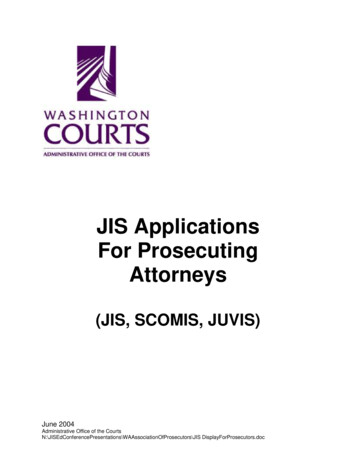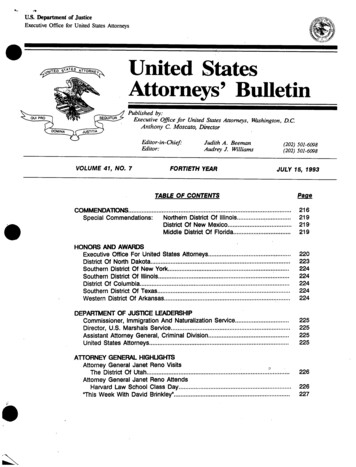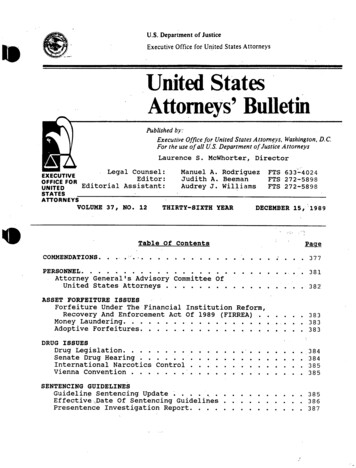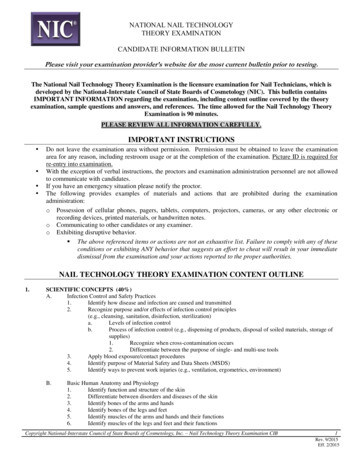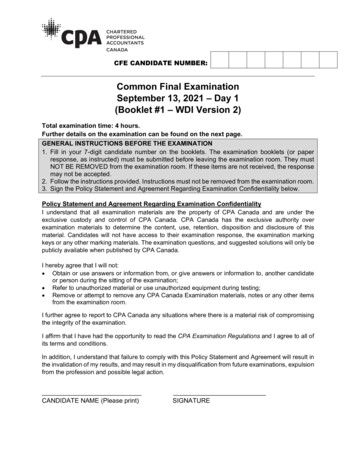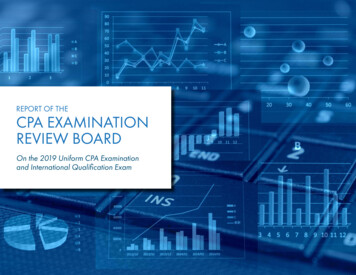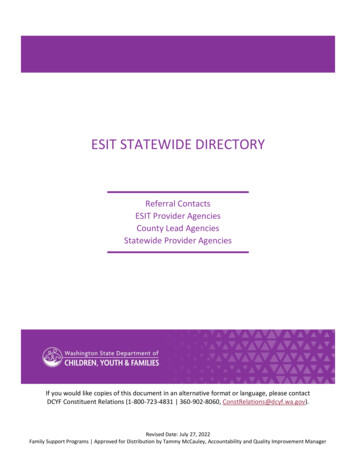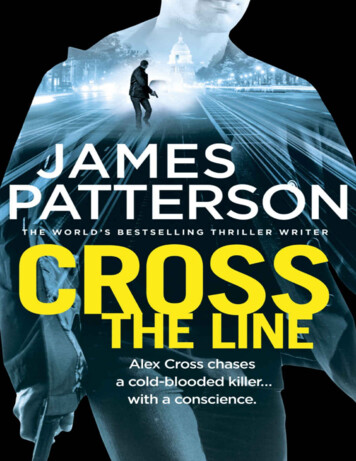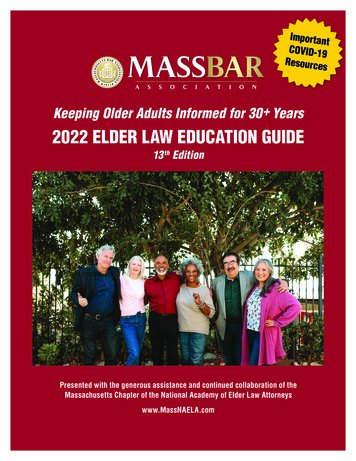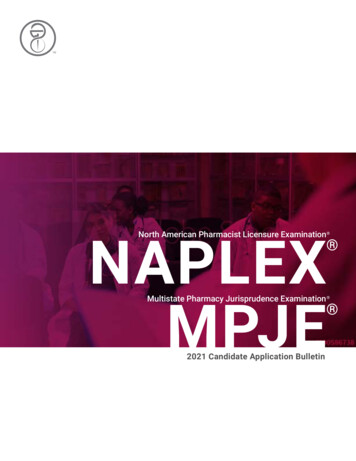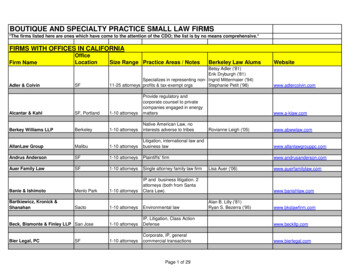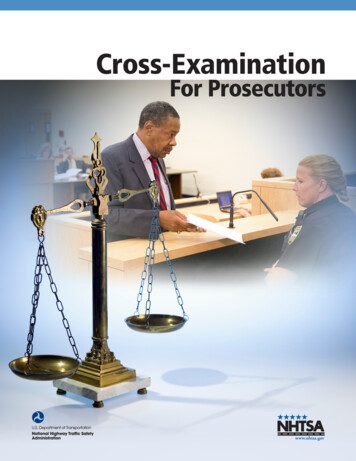
Transcription
Cross-ExaminationFor Prosecutors
The National Traffic Law Center is a program of the National District AttorneysAssociation. This document was prepared under Cooperative AgreementNumber DTNH22-05-H-05166 from the U.S. Department of TransportationNational Highway Traffic Safety Administration. Points of view or opinions inthis document are those of the authors and do not necessarily represent theofficial position or policies of the Department of Transportation, NHTSA, or theNational District Attorneys Association.
Table of ContentsINTRODUCTION . iiiACKNOWLEDGEMENTS . ivPREFACE . vOBJECTIVES FOR CROSS-EXAMINATION . 1PREPARATION .2Reviewing the case file . 2Interviewing all witnesses . 3Visiting the scene . 3Anticipating the defense . 4METHODS OF CROSS-EXAMINATION . 6Gaining Concessions . 6Reiterating and Emphasizing Facts . 7New Facts . 8Alternative Facts . 8Deleted Facts . 9Mistakes . 9Impeaching a Witness . 10Bias . 10Perception and Recall. 10Lack of Personal or First Hand Knowledge . 12Competency . 13Physical Evidence . 14Inconsistencies . 14Prior Inconsistent Statements . 15Prior Consistent Statements . 16Behavioral Inconsistencies . 16Lack of Corroboration . 16Prior Bad Acts . 17Character and Credibility . 17Criminal Convictions . 17CONTROLLING CROSS-EXAMINATION . 18Form of Questions . 18Order of Questioning . 19CROSS-EXAMINATION OF THE EXPERT WITNESS . 19Identifying the Expert Opinion and the Basis for It . 20Research the Witness’s Background . 21Research the Science . 22Challenging Expertise . 23Impeachment of an Expert Witness by Prior Inconsistent Statements . 24Impeachment Using an Article Written by the Witness . 26Countering Escape and Evasion Techniques . 27CONCLUSION .28i
EXPERT WITNESS ADDENDUM . 29Medical Experts . 29Collision Reconstructionists . 29APPENDIX .33Resources and References .33General Resources .33Medical Expert Resources .33Administrative and Federal Procedure . 34Crash Reconstruction Resources . 34Suggested Reading . 34Other Publications Available From the National Traffic Law Center .35ii
INTRODUCTIONCross-examination is an art form only occasionally practiced by prosecutors, whoinstead necessarily focus much of their efforts on direct examination. This is brought onby the prosecution bearing the burden of proof and the simple realities of many criminaltrials where the defense may choose to present few or no witnesses. DUI cases, however,are often complex and more scientific or technical in nature than many other types ofcriminal cases. Accordingly, the prosecutor’s opportunity to conduct a cross-examination,particularly of an expert witness, is greater.This monograph was developed to assist prosecutors in understanding the basicgoals, methods, and forms of cross-examination when dealing with all witnesses. Inaddition, the monograph provides guidance specific to expert witnesses.The National Traffic Law Center previously published Basic Trial Advocacy forProsecutors, thanks to a contribution from a charitable foundation, discussing such trialadvocacy topics as pre-trial preparation, voir dire, opening, direct examination, crossexamination and closing argument. In addition, the National Traffic Law Center created aDWI Prosecutor’s Handbook, in collaboration with the National Highway Traffic SafetyAdministration and various vehicular crime prosecutors and experts from across thecountry. This monograph covers such topics as case evaluation and review, trialpreparation, and common defenses and challenges. Both monographs may be obtained bycontacting the National Traffic Law Center of the National District Attorneys Associationat trafficmail@ndaa.org or 703-549-9222.For the purposes of this publication the terms DUI (driving under the influence),DWI (driving while intoxicated or impaired) and OUI (operating under the influence) areconsidered interchangeable for the purposes of this publication.iii
ACKNOWLEDGMENTSThis guide was created by the National Traffic Law Center of the National District AttorneysAssociation and is the result of a collaborative effort of the following traffic safetyprofessionals:James Camp, Tennessee Traffic Safety Resource ProsecutorErin Inman, Montana Traffic Safety Resource ProsecutorJoanne E. Michaels, Program Director, National Traffic Law Center of the NationalDistrict Attorneys AssociationMark M. Neil, Senior Attorney, National Traffic Law Center of the National DistrictAttorneys AssociationDeena Ryerson, Oregon Traffic Safety Resource ProsecutorKristen K. Shea, Senior Attorney, National Traffic Law Center of the National DistrictAttorneys AssociationJohn E. Sullivan, III, Rhode Island Traffic Safety Resource ProsecutorBrian Chodrow, Program Analyst, Impaired Driving Division, National Highway TrafficSafety Administration, served as the Contracting Officers Technical Representative forthis project.iv
PREFACEEffective cross-examination is a critical part of any criminal trial. Never is thismore true than when technical or scientific evidence is a central issue for the jury. Withthis being said, prosecutors often feel uncomfortable during cross-examination of defensewitnesses. This is not due to lack of ability. Rather, it is caused by insufficient practice,focus, and preparation for this part of the trial. As prosecutors, we generally expend mostof our effort on “proving our case” in chief and experience a feeling of relief when theprosecution “rests.” In reality, the State’s case is far from over at the end of the State’spresentation of evidence. The simple message is that case preparation includes preparingto overcome any defense theory because it is often when the State’s case ends that themost difficult work, cross-examination of the defense witnesses, begins.In order to succeed at cross-examination, a prosecutor must understand the goalsof each party in a criminal trial. This allows a prosecutor not only to block the defensetactics, but also to use skillful questioning of defense witnesses to illicit responses favorableto the State. The goal of the defense during trial is to cast doubt in the minds of the juryon behalf of their client. This goal can be accomplished in several ways: (1) minimize theState’s case through pretrial motions to suppress evidence; (2) minimize the State’s casethrough the cross-examination of State’s witnesses; (3) minimize the State’s case bycalling their own witnesses to present evidence for the jury and (4) bombard the jurywith enough technical or scientific testimony to cause confusion. Any of these methods, ifunchallenged, can result in the creation of reasonable doubt.Effective prosecution, at its core, the means presenting sufficient evidence to convict adefendant of the crimes charged through direct evidence. Keeping this goal foremost in mindallows a prosecutor to focus more on the case-in chief. Often a prosecutor will not evenknow if the defense will present evidence until after the State rests. At that point, skilledand effective cross-examination of the defense witnesses becomes critical for a prosecutor.He or she will work through cross-examination of any defense witnesses with two coregoals. The primary goal is preserving the integrity of the State’s case and the secondarygoal is to obtain any favorable facts, concessions or inconsistencies possible. While aprosecutor should not plan on winning the case through cross-examination of defensewitnesses, a poorly planned or executed cross-examination could impact the success of thecase and the prosecutor’s credibility with the jury. A well-prepared prosecutor can bothobtain helpful factual admissions supporting the State’s case from the defense witnessesand minimize the defense case through impeachment of the defense witnesses.This monograph is intended to assist prosecutors in successful cross-examination.Careful consideration and adherence to the thoughtful strategies contained within willincrease the chances of the desired outcome, a verdict of guilt. With time and practice,any prosecutor can become a master of the art of cross-examination. No matter hownatural a seasoned prosecutor’s cross-examination skills may appear, it took years oftraining and experience to become truly proficient.v
OBJECTIVES FOR CROSS-EXAMINATIONWhen a prosecutor takes a case to trial, the primary goal is always a conviction. Toachieve this end, prosecutors will have specific objectives and goals for each portion of the trial.Before beginning any work on cross-examination, a prosecutor needs to carefully consider his orher objectives for each witness that will be presented. How can this witness hurt the case? Howcan the witness help the case? How important is the witness and how much time should be spenton cross-examination? Does this witness require any cross-examination at all? It is important todetermine whether or not to examine each and every witness put on by the defense. If the witnessdid not hurt the State’s case, cannot help the State’s case and can offer no additional positiveevidence for the State through cross-examination, cross is not necessary. It is difficult to pass upan opportunity for a devastating cross-exam, but attorneys must resist the temptation to showcasetheir skills.Cross-examination by the defense asks the jury to question what was done procedurallyduring the stop and arrest, to challenge the validity of scientific tests or to doubt the law enforcementofficer’s competency or even integrity. The prosecutor’s cross-examination can be an effectivetool to repair any damage that occurred in defense cross or direct testimony by bolstering thejury’s faith in the fairness of the prosecutor and officer and their search for truth.Many would argue that the practical purpose of cross-examination is simply to undermineor destroy direct testimony. However, the legal purpose of cross-examination is a good faithquest for ascertaining truth and the prosecutor should use it justly and legitimately. Crossexamination of fact witnesses will differ from that of expert witnesses but a prosecutor’s goalsremain the same. Choosing the type and form of cross-examination, therefore, should be done inlight of the State’s theory of the case and organized in such a manner as to reduce confusion andseek the truth.There are four basic goals for a prosecutor to consider in the cross-examination of eachdefense witness: Obtain factual admissions helpful to the State’s case; Corroborate the testimony of the State’s witnesses; Minimize the defense case by impeachment of the witness on the stand; and Minimize the defense case by impeachment of other defense witnesses through thewitness on the stand.Prosecutors should prepare a cross-examination for each witness in light of each of thesegoals. This is critical because the defendant’s witnesses may provide the last testimony heard bythe jury prior to closing argument. However, the prosecutor can make use of cross-examination toensure that some of that evidence either bolsters the State’s case or undermines that offered by thedefense, or, better yet, both. Cross-examination and its execution can be varied. Personal choicesas to style and techniques will dictate how specific facts and specific witnesses are approached.1
PREPARATION“If I had 8 hours to chop down a tree, I would spend 6 hours sharpening my axe.”- Abraham LincolnWhile it sounds overly simple, proper preparation for the direct case is the best way toprepare for cross-examination of the defense witnesses. Knowing the strengths and weaknessesof the State’s case will assist in anticipating the type of defense and the possible defense witnessesthe defendant will rely upon. Proper preparation of the State’s case should include the following:Reviewing the case fileThe first step in preparing for a cross-examination is to review the entire file. This will givethe prosecutor an overview of the case and a framework from which to work. One of the mostimportant elements of a thorough case review is to go over all witness statements. These statementscome in many forms and could be found in police reports, witness statement forms,911 or other emergency recordings, text messages, depositions from concurrent civil litigation,published articles, recorded police interviews, or any prior sworn testimony from the case athand or prior cases. Thinking “outside the box” may enable a prosecutor to locate very usefulcross-examination material.The prosecutor can also use the review of the file to assess the file for completeness. Isanything missing? Did the police interview all the witnesses mentioned in the file? Was all theevidence seized and tested properly? Are there any holes in the investigation the defendant willattempt to exploit? What expert or other witnesses will the defense attempt to call that candamage the State’s case? Sometimes, this process will identify problems that need to be addressedbefore trial. If the prosecutor is aware of a defendant’s admission but unable to locate it in theoriginal report, it may be necessary to have the investigating officer prepare and submit asupplemental report. If the expert’s written report seems incomplete, it may be necessary to havethe expert provide some supporting documentation.Every prior statement of a witness may be fodder for incisive questioning. Failure to identifyand thoroughly review these statements might mean a lost opportunity to expose testimonialinconsistencies or bias. As a prosecutor becomes familiar with the prior statements it shouldbecome more clear which facts and/or opinions this witness will likely offer during a trial orhearing. Understanding the potential content of a witness’s direct testimony is critical to determiningthe extent to which this witness may damage the State’s case. A witness who does little ornothing to the State’s case will not require as extensive cross-examination as a witness who canundermine or contradict a fact necessary to establish guilt. No prosecutor can predict with 100%certainty what any witness will say, but preparation is the best way to avoid being caught offguard. Forewarned is forearmed.2
Interviewing all witnessesMeeting with the prosecution witnesses before the trial is important because it gives theprosecutor the opportunity to assess how they will react to the stress of the courtroom and beingsubjected to cross-examination. This is the best time to emphasize the importance of truthfultestimony based on knowledge, not guesswork. It also gives the prosecutor the opportunity to askthe questions police officers may have omitted in their initial interview and fill in any holes in thetestimony. Last, it gives the opportunity to explain the courtroom procedures and prepare eachwitness for their cross-examination. Witnesses who have not testified before will benefit frompreparation including becoming familiar with the layout of the court, the personnel who will bepresent and the form and content of the expected examination process.In cases where a particularly damaging fact or opinion witness is anticipated, the State’switnesses may be excellent resources. A fact witness may be able to give a detailed account thatallows a prosecutor to expose critical weaknesses or inconsistencies in a defense witness’stestimony. A State crime lab toxicologist or law enforcement crash reconstruction expert will beable to help the prosecutor understand the opinions offered by a defense expert. Moreimportantly, those State experts, if given enough opportunity prior to trial, may be able to assistthe prosecutor in trial strategy. State experts may offer direct testimony or rebuttal testimony thatundermines the defense theory. Also, State experts may be able to suggest areas were the defensetheory is weak and enable the prosecutor to ask particularly effective questions. Prosecutors shouldkeep in mind that the State’s fact or expert witnesses may be personally or professionallyfamiliar with the defense witnesses. The simple question of “what can you tell me about thisdefense witness” should never be overlooked.Access to defense witnesses is often limited prior to trial. A prosecutor should not hesitate,however, to attempt contact with a non-defendant defense witness. Defense attorneys will certainlytry to make contact with the State’s witnesses prior to any cross-examination. If a defensewitness is willing to talk to the State prior to giving testimony, it is best to get as muchinformation as possible by asking open- ended questions such as “Can you explain more aboutyour theory in this case?” Ideally, a witness would agree to being recorded or t o discussinghis theories in the presence of the investigating officer. If this is not possible, the prosecutorshould take concurrent, detailed notes of the conversation.Visiting the crime sceneOne of the most important things prosecutors can do is familiarize themselves with the entirescene or scenes of the crime. This is particularly true in motor vehicle crash cases. Some officesallow their prosecutors to respond to the scene immediately after the crash and before any vehicleshave been moved. In these situations, the prosecutor’s role is one of observer. Immediate response toa crash site is an excellent opportunity for the prosecutor to observe the scene. Trial preparationshould begin from the moment the prosecutor is notified of the potential crime.Traffic crimes in particular, even those not involving crashes, often involve factual disputesregarding the scene of the driving or arrest. In cases involving field sobriety tests, for instance aprosecutor can expect the well prepared defense attorney to arrive at trial with photographs ofthe roadside scene of the arrest that depict poor lighting, a steep grade or other similar points toundermine the idea that it was intoxication that caused poor performance. Likewise, a defense3
expert may arrive with scene photos of neon lights or radio towers near the scene at which thebreath test occurred to support his argument that it was interference and not alcohol causing thehigh blood alcohol concentration (BAC) results. By visiting the scene of the arrest, crash, or bar,the prosecutor can more effectively defend against surprise attack and ask effective questions oncross. The best way to prepare is to visit the scene with the investigating officer. At the scene,review landmarks, relevant distances and other pertinent details. Knowing these details helps theprosecutor prepare for questioning the witnesses on both direct examination and crossexamination. It will also help the prosecutor to craft specific questions whose answers can betterdescribe the scene for the jury.Anticipating the defenseAfter a thorough review of the case, the potential defenses and the types of witnesses shouldnow be apparent. Sometimes, the defense opts to dispute directly the fact or opinion testimony.In these cases, witness preparation is particularly important because a juror may base his decision onthe perceived credibility of the witness. Rather than risk offending the jury by a hostileexamination of an uninvolved witness or public servant, the defense will undermine the State’scase more subtly. This form of attack may involve implying that a witness simply made a mistakeor has a well-meaning bias. Basically, the defense explains what it can and mitigates what itcannot.Just as the State has a theory of its case, so will the defense. Generally, defenses theoriesfocus on two areas: (1) identification or (2) confess and avoid. Identification cases involvesituations where the identity of the defendant is the main issue in the case. In these cases, thedefense will argue that the State has accused the wrong defendant. This is commonly referred toas the SODDI or “some other dude did it” defense. In impaired driving cases, this often occursafter a crash when the occupants have gotten out of the car or been thrown around within the carbefore the officer can respond. The defendant may blame another person at the scene or a“ghost” driver who allegedly fled immediately before the police arrived. In these cases, thedefense theory will focus on negating or weakening any identification testimony offered by theState’s witnesses. Expect the defense to offer witnesses consistent with this case theory.Identification witnesses offered by the defense are often the friends and/or family membersof the defendant. Alibi or identification defense witnesses may be lying or may be actuallymistaken. It’s never a good idea to attack a sympathetic witness who has made an honest or goodfaith error. Careful examination can reveal hidden weakness, biases or intentional wrong doing.Cross-examination of defense identification witnesses should focus on several areas, including: the relationship between the witness and defendant;how the witness first learned of the case or obtained his or her knowledge of the case;his or her actual ability to perceive the facts of the case; andthe identity of any others who were present.4
Identification witnesses testifying to alibi may be willing to agree wholly with the facts of thecase, since they are only concerned with placing the defendant away from the scene, or at least, notin the driver’s seat. Similarly, if the witness saw that the defendant did NOT commit the crime thenthey may have seen who did. It is important to note whether or not a witness contactedauthorities to name the correct defendant and how promptly the witness took any action tocorrect the alleged injustice.When multiple witnesses offer this type of testimony it is critical to establish inconsistenciesbetween their testimonies during cross-examination. If the stories are all exactly the same, thisunlikely occurrence may be grounds for argument in closing. The prosecutor should bring out oncross how much conversation the defendant, the defense attorney or other defense witnesses havehad with this witness prior to his testimony. Often, the defendant will make post-arrest admissionsto defenses witness that may be helpful to the State’s case. While “fishing” for admissions shouldbe avoided during trial, a prosecutor can make great discoveries during a pre-trial interview or bylistening very carefully during trial to all witness responses and asking specific follow-up questionswhere appropriate.During a trial, a prosecutor can develop a type of auditory “tunnel vision” during direct orcross-examination. The prosecutor becomes so focused on the prepared list of questions that he orshe forgets to pay close attention to the witness’s responses. This could allow a damaging fact to gounaddressed during direct or permit a very favorable fact to slip away during cross. If a prosecutorshould plan a thorough cross for identification witnesses then listen to the entire response andask pertinent follow-up questions. He may be able to expose a hidden relationship, bias, or weaknessin that witness’s testimony. This can be devastating to the defense. During summation, theprosecutor can argue effectively that the credibility of the witness is tainted and any testimonyshould be viewed with suspicion.Confess and avoid cases involve situations where the defendant cannot challenge theidentification. In these cases, the defense must somehow disprove the facts of the case offered bythe State. This defense theory focuses on eliminating one or more of the factual elements of thecrime. In an impaired driving case, for instance, a fact witness may testify to an alternateexplanation for the smell of alcohol or offer a different view point of the defendant’s pre-arrestdriving behavior. Usually, this witness will agree with many of the facts offered by the State’switnesses. Cross-examination of these witnesses should attempt to elicit responses that offer proofof as many facts supporting the State’s cases as possible. This is an opportunity to have key factsreiterated and to corroborate facts that were brought out in the State’s case in chief.5
METHODS OF CROSS-EXAMINATION“The commander must decide how he will fight the battle before it begins. He mustthen decide how he will use the military effort at his disposal to force the battle toswing the way he wishes it to go; he must make the enemy dance to his tune from thebeginning and not vice versa.”- Viscount Montgomery of AlameinIn any court proceeding, a prosecutor is limited by governing evidentiary rules and rulesof practice for the court presiding over the case. The Federal Rules of Evidence (FRE) offerlimited guidance on the style or substance of cross-examination and pertain more directly to thescope of the permissible questions. FRE 611 dictates that “cross-examination should be limited tothe subject matter of the direct examination and matters affecting the credibility of the witness” butallows the judge to permit attorneys to inquire “into additional matters as if on directexamination.” Some States allow for “wide-open” cross-examination on any relevant matter if theattorney has a good-faith basis for asking the question. A prosecutor should have a workingknowledge of the State- specific rules of evidence that apply to his jurisdiction and craft hiscross-examinations accordingly.Once a prosecutor understands the legal parameters, he can focus on the methodology hewill use to construct an effective cross-examina
Cross-examination is an art form only occasionally practiced by prosecutors, who instead necessarily focus much of their efforts on direct examination. This is brought on by the prosecution bearing the burden of proof and the simple realities of many criminal trials where the defense may choose to present few or no witnesses. DUI cases, however,
